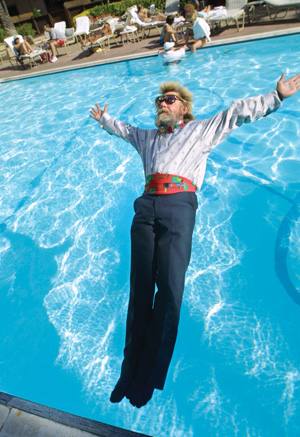THROUGHOUT its long bar-studded history, downtown San Jose never experienced a man, myth or legend quite as provocative, multidimensional and entertaining as James Martin Nysted, who passed away on July 22 at the age of 69.
He was an independently wealthy Vietnam veteran, mathematician, U.S. Chess Grandmaster, used-car collector, gadfly, conspiracy theorist, prolific writer, pianist, disputed Lutheran, art-class model, choir singer, homeless and mental-heath advocate and drinking buddy for anyone who would listen to him.
When he wasn’t checking in at the VA Hospital in Palo Alto, practicing Beethoven’s Moonlight Sonata in the Music Building at SJSU or purchasing yet one more used car from the Salvation Army on Taylor Street, he found his home in the various watering holes of the neighborhood, often just looking for other creative minds to chat with. He was known for reciting Edgar Allan Poe’s “The Raven,” by memory, in its entirety.
Conversing and drinking with Jim was sometimes just like reading his stream-of-consciousness manuscripts, which he often handed to everyone in the entire bar. Fantasy blurred with reality in the most poetic fashion. We spent days, perhaps years, philosophizing, arguing, conspiring, pontificating, complaining, lecturing, psychoanalyzing and diagnosing with each other.
We drank and laughed for hours on end, often holding court right inside the gate at Gordon Biersch on San Fernando Street, thoroughly perplexing the more civilized folks who ambled their way in. Several of those conversations provided source material for ideas I used in my own writings, this column especially.
Jim was also a chess grandmaster and although not completely invincible, he could usually destroy anyone who attempted to play him. At the old Katie Bloom’s on South First Street, the bartender would set up a chessboard on the bar, and the matches would continue into the night. Even when hammered out of his mind, Jim could still beat most people. He adored the King’s Gambit, he loathed castling queenside, and he would carry on all night about the Ruy Lopez opening. At the same time, though, he was deeply at war with himself over having lost the “killer instinct” for the game.
Over countless drinking sessions, Jim elaborated that the killer instinct at chess is what furnished him with a passageway to a different reality. That is, he could do things on the chessboard that he couldn’t do in real life. For him, this was tangible proof that imagination could be made real.
Over at SJSU, Jim deliberately seeped into every circle of people imaginable. He was one of those characters from the ’60s who just never managed to escape the sphere of the campus community. (There are many others—they either wound up in mental institutions or simply became SJSU employees for decades.)
But Jim, at least not recently, was never one for traditional concepts like “work.” He had his pile—however much, he would never tell—and instead spent his time collecting used cars, parking them all over downtown and subsequently irritating police officers and meter maids throughout the land. His most famous line was “I started with nothing in life and managed to hold on to half of it.”
There is no summary. Jim was a man who couldn’t be reduced to any one essential theory or practice. He was totally postmodern, or perhaps more specifically, poststructuralist. There were multiple structures of thought in his brain, each one navigating its own trajectory, but all of which, somehow, were still connected. You can take any term from Deleuze and Guattari’s A Thousand Plateaus and apply it to Jim. Easily. He was a glorious weed between the cracks of downtown San Jose public life.
“There are two things worth mentioning,” he once told me. “One is that the imagination can be made real on the chessboard. The other is that chess is life. When both of these are gone, then it’s time to quit.”




